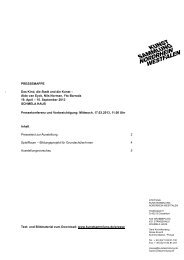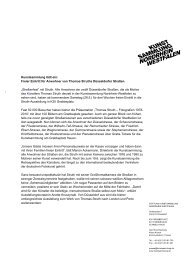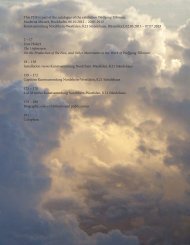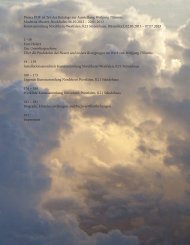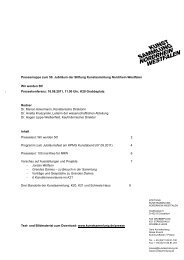Download online catalog (pdf)
Download online catalog (pdf)
Download online catalog (pdf)
Create successful ePaper yourself
Turn your PDF publications into a flip-book with our unique Google optimized e-Paper software.
are not constitutive to the perception and the generation of meaning in works of art. Both the<br />
institutional backdrop of art and each individual art institution in which Tillmans’ works are<br />
exhibited contribute to the institutionalisation of the artist and to the construction of specific<br />
modes of perception.<br />
The visitor to an exhibition of the work of Wolfgang Tillmans in the year 2012, in this<br />
case the author of these lines, arrives in expectation of a particular, clearly defined type of art<br />
and image experience. A sense (however fragmentary) of the artist’s past exhibitions and publications<br />
is always present in any encounter with his work. And this includes the need to see the<br />
‘abstract pictures’ in the context of an œuvre where realistic and abstract elements have never<br />
intentionally been separated from each other. On the contrary, abstraction is always co-present<br />
with figurative and representational elements. There is no contradiction between forms and<br />
matter free of meaning – that is to say, visual moments that on the face of it neither represent<br />
nor illustrate anything – and Tillmans’ photographs of people, animals, objects and landscapes;<br />
in fact there is an unbroken connection, a continuum. This applies both to individual images<br />
as much as to the internal, dynamic relationalism of his œuvre as a whole. And it also applies<br />
to each individual, concrete manifestation of multiplicity, as in the case of the installation in<br />
the first room of the exhibition in Warsaw.<br />
Both aesthetic theory and the institution of art itself provide decisive grounds for<br />
discussing photography and visual art in such a way that images are not solely considered in<br />
terms of documentary functions or ornamental aspects nor are they reduced to the question as<br />
to whether their contents are stage-managed or authentic, but that attention is paid instead to<br />
the material nature of the pictures and objects in the space, to their sculptural qualities. Having<br />
decided early on against a career as a commercial photographer and in favour of a life in art,<br />
there was no need for Tillmans to seek to justify the interest he had already felt in his youth<br />
in a non-hierarchical, queer approach to various forms and genres in the visual arts. For the<br />
young Wolfgang Tillmans the cover artwork for a New Order LP, a portrait of Barbara Klemm<br />
(in-house photographer at the Frankfurter Allgemeine Zeitung), or a screenprint collage of<br />
Robert Rauschenberg in Kunstsammlung Nordrhein-Westfalen were all ‘equally important’<br />
images’. 7 The mobilisation and reversal of value and meaning are central strategies in his praxis.<br />
He questions the ‘language of importance’ 8 in photography and alters valencies of the visual by,<br />
for instance – in a ‘transformation of value’ 9 – producing C-prints from the supposedly impoverished<br />
or inadequate visuality of old black-and-white copies or wrongly developed images<br />
and thus raising them to the status of museum art. However much he may set store by refinement<br />
and precision, he avoids conventional forms of presentation, that is to say, ‘the signifiers<br />
that give immediate value to something, such as the picture frame’. 10<br />
In November 2000 the London fashion and lifestyle magazine i-D, for which Tillmans<br />
himself regularly worked from 1992 to 1995, published a long feature on Tillmans by<br />
Kodwo Eshun. Looking back at the early and mid-1990s, Eshun wrote that ‘to see a Tillmans<br />
image then was to experience the immediate thrill of short-circuited hierarchies, of worlds<br />
7 Wolfgang Tillmans, email of 12 May 2012.<br />
8 Julie Ault, ‘The Subject Is Exhibition. Installations as Possibility in the Practice of Wolfgang Tillmans’, in<br />
Wolfgang Tillmans. Lighter (Stuttgart/Berlin: Hatje Cantz/SMB), Nationalgalerie Staatliche Museen zu Berlin,<br />
2008, 15-22 at 16.<br />
9 See Hans Ulrich Obrist, Wolfgang Tillmans (Cologne: Verlag der Buchhandlung Walther König, 2007 = The<br />
Conversation Series, 6), 41.<br />
10 Gil Blank, ‘The Portraiture of Wolfgang Tillmans’, in Influence, 2, autumn 2004, 110–121 at 117.



